|
|
|
Barnard-Mastin 6BRX
Parker's Pride: Benchrest Accuracy in a Prone Match Rifle
Other Guns of the Week >
6BR Improved cartridges aren't just for Benchrest rigs. Scott Parker has put together a 6BRX that is one of the most accurate prone rifles we've ever seen. After hearing some amazing accuracy reports from Scott we joined him at Bakersfield's "5 Dogs" range for a range session. Watching Scott shoot his wondergun with sling and irons, this editor came away impressed beyond belief by the BRX. Through a spotting scope I saw him string a dozen Xs in sequence at 200 yards. At one point he popped his spotter golf tee 4 times in a row. When we pulled the target, we measured that 4-shot cluster at about 0.3" (0.15 MOA) center to center. And he did all that with iron sights and sling--no scope or rest! In Scott's hands, this wicked 6BRX redefines prone precision.
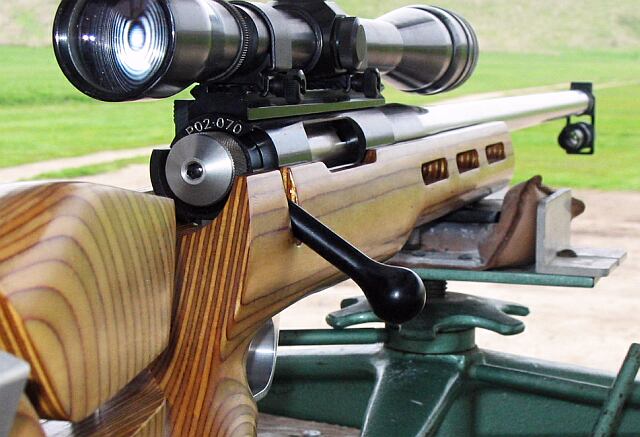
A Prone Rifle That Shoots in the 'Ones' with a Palma Barrel
Scott tells us: "My goal with the project was to build a dedicated prone rifle for long-range competition using top-of-the-line components. My club has regular 600-yard prone matches, and there are some 1K matches at nearby ranges. Originally, I planned to chamber the rifle in 6.5-284. However, after reading many articles and posts about the 6BR Improved cartridges, I decided on the 6mm BRX chambering. I figured that this would provide good barrel life, exceptional accuracy, and great ballistic performance out to 1000 yards. My good friend and rifle-builder, (who will remain anonymous for now), liked the idea of the cartridge and ordered a 6BRX reamer from Dave Kiff. On the strong recommendations of my smith, I purchased a Barnard action and a Mastin offset prone stock. I needed a superior barrel, so I called Broughton Rifle Barrels and spoke with Tim North. Tim shipped a 6mm, 1:8" twist, 5C medium Palma-contour barrel about two weeks later.
| Left Target is 5 shots at 100 yards, from benchrest with 30x scope, and rear sandbag. | Right Target is 10 shots at 100 yards, fired prone with iron sights, sling support only. | 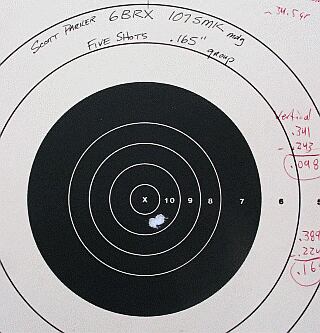 | 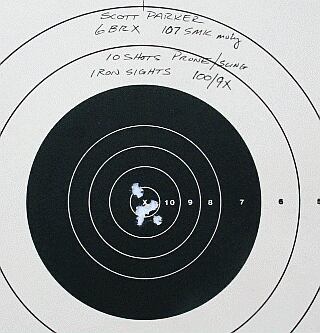 |
Fire Forming and Load Development
For those not familiar with the 6BRX cartridge, it is a 6mm BR Norma with the shoulder blown forward, increasing case capacity about 4 grains. Unlike the 6 Dasher, it retains the parent case's 30° shoulder. Initial fire-forming started with 29.5 grains of Varget and 107gr moly SMKs jammed. However, primer piercing occurred. Once I upped the charge to 30.5 grains, the piercing problem went away, and the unturned cases fire-formed nicely. [Editor's note: Scott used the simplest fire-forming method--just jamming the bullet hard into the lands so the case seats firmly against the bolt head. Alternatively, you can neck the case up one diameter to create a false shoulder, then neck-size the top half of the neck back down to 6mm. This might have produced better results with the lesser load.]
Load development required little time and effort. Based on input from other 6BR Improved shooters, I knew Varget would work within about a three-grain load window. The only initial problem was that the Mastin stock, with its ergonomically-offset butt, was unsteady during recoil--it would simultaneously yaw, pitch and roll. My smith fixed that with a custom metal bag-riding fixture that replaced the adjustable buttplate. With that slick "Parker Pod", plus a Hart Accuracy Asset plate bolted to the forearm, the gun rode the bags like a dream.
So, handling issues resolved, I started load development with 98 pieces of fire-formed brass. I ran a ladder test at 100 yards with 11 shots covering from 32.5 grains to 35.0 grains of Varget. This was fruitless since all 11 shots went into a group less than .5". I re-tested charge weights with 3-shot groups and evaluated them for size and shape. Two sweet spots appeared with groups in the mid 'Ones'. The lower charge weight was 33.5 grains at 3020 fps. The upper spot was at 34.5 grains and 3104 fps. Both loads used CCI BR4 primers, about .0015" neck tension, and moly-coated 107s seated .015" off the lands. I Loaded 10 rounds at both charge weights and did 5-shot groups. Both loads grouped less than .170" center to center as shown in the above left target. I then loaded 10 rounds and shot prone with iron sights and a sling. This produced a 100-9X (right target above) on a 100-yard reduced prone target, which has an X-ring roughly 0.75" in diameter.
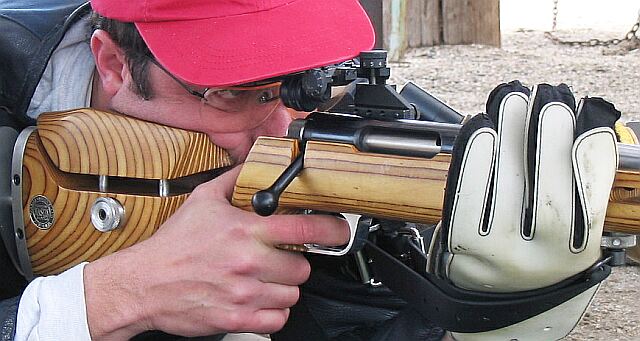
For 600 Yards and Beyond
As noted above, this rifle was purpose-built for long-range prone competition. That's why I picked the Mastin stock. The offset buttstock puts my right eye directly behind the rear sight. The rifle's center of gravity rests on the ball of my support hand when in position. The grip is generous in size and well contoured to the human hand. The overall feel is natural, comfortable, elegant and honest. This rifle is easy to shoot. Although the recoil is a bit heavier than my .223 bolt gun, the recoil is still very mild. It also has a very distinct quality to it -- it feels positive and precise. I attribute this to the V-block bedding system and the laminated stock. I have never fired a rifle that instilled so much confidence. You lay down with this rifle and you trust it implicitly. The recoil tracks vertically and allows me to call my shots even inside the X-ring. The Mastin is comfortable beyond my expectations. And the accuracy is almost supernatural. This is the most accurate prone rifle I've ever shot.
I'm delighted with my cartridge choice. I believe the 6BRX can match or beat any other cartridge out there for long-range prone competition. It offers excellent ballistics, superb accuracy, low recoil, and you can use standard 6mm BR Redding dies. The BRX will drive high (.53+) BC 105-107gr bullets at 3000-3100fps. A 10 mph crosswind produces only 21" of drift at 600yds and 72" at 1000yds. Run the numbers, and you'll see that's comparable to a 6.5-284 shooting 142gr SMKs at 2950 fps. Yet the BRX burns 30% less powder and offers double or triple the barrel life of a 6.5-284! What's not to like? The Lapua brass is excellent, and I don't turn necks. I seat the bullets with the bottom of the bearing surface about .015" above the neck-shoulder junction. It would be nice to be farther from the doughnut but the short BRX neck limits you in that respect.
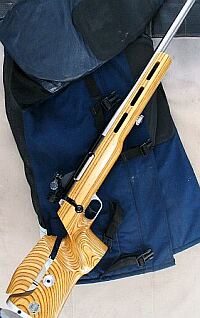 Rifle Specifications Rifle Specifications
We used a Dave Kiff 6BRX reamer with a .271" neck, and .187" freebore. (The short BRX neck requires extra freebore; a standard 6BR reamer set for 107 SMKs might have .110" freebore). The Broughton 5C (canted lands) barrel was crowned at 31" with the muzzle turned to .750" for the front sight fixture. The offset prone stock features an aluminum V-block that allows a barreled action to be fitted without conventional bedding. The Mastin arrived fully inletted with V-block in place, but it did require external finishing. RPA made both the ladder front sight and micrometer rear sight. The front sight rotates down and out of view when a scope is used. It is indexed with a detent so it returns to zero precisely when rotated back to the upright position. Mac Tilton, MTGuns, fabricated the rear sight base and the scope base. Mac is also the importer for both Barnard actions and Mastin stocks. The rifle weighs about 14 pounds in match (iron sight) configuration.
The Barnard Action
The Barnard is a New Zealand product, designed for long-range use, principally Palma competition. CNC-machined from solid steel, the stiff and beefy Barnard is favored by Palma smiths worldwide. It is made to very close tolerances with zero slop. The action has a precision ground exterior with a handsome blued satin finish. The massive bolt and its three locking lugs provide solid lock-up with silky bolt closure. Bolt operation is smooth and positive. The design is brilliant in its simplicity.
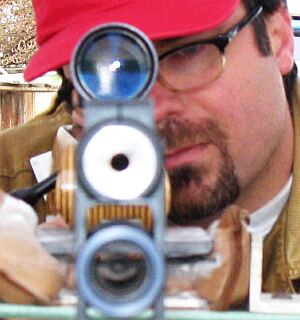 Long-Range Shooters' "Great Debates" Long-Range Shooters' "Great Debates"
Quite a few experienced High-power shooters say that load development should always be done prone and not from a bench with a rest. To be blunt, that's nonsense. Shooting from the bench minimizes "operator-induced error", and gives you a better sense of the ammo's true capabilities. And a Palma-style rifle works fine from the bench--just bolt a wide metal plate to the forearm and attach a bag-riding fixture beneath the butt-stock. This allows you to test loads using a quality rest and bag just like the BR guys do. (And it works--check out my 0.165" group, shot from the bench with a 30x scope.) When your bench-work confirms a competitive load (10 shots under .5 MOA), THEN go ahead and shoot that load prone, not before. Otherwise you're testing your sling skills, not your load's true accuracy potential.
Also, some folks believe short-range (100 yard) results are not meaningful. Again I disagree. If a load won't shoot at 100 yards, I don't shoot it. A failure to group well at short range is just that, failure. Uniformity in bullets is extremely important, especially at long range. Don't cut costs when it comes to match bullets. If your projectiles are not uniform enough, then you should sort and segregate them by weight and/or bearing surface. And if that doesn't solve the problem, send those bullets back to the manufacturer and demand better quality. I'm skeptical of the "bullet fixing" devices. Do not buy a broken pencil sharpener to "fix" cheaper bullets. Grinding off bullet tips with aftermarket tools is not the answer.
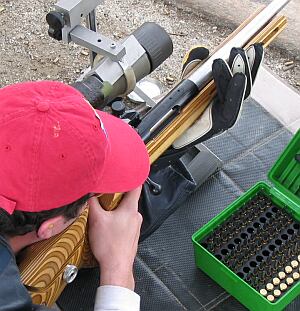 As to the Moly Debate--I am firmly in the pro-moly camp. I've shot tens of thousands of moly rounds. If there is a downside, I have not found it yet. My experience shows that moly makes cleaning easier, and most importantly, accuracy holds through prolonged periods of shooting. The smallest group that I shot with this rifle occurred with 40+ rounds through the barrel since its last cleaning. I moly-coat my own bullets and I am careful to apply a very even coating. As to the Moly Debate--I am firmly in the pro-moly camp. I've shot tens of thousands of moly rounds. If there is a downside, I have not found it yet. My experience shows that moly makes cleaning easier, and most importantly, accuracy holds through prolonged periods of shooting. The smallest group that I shot with this rifle occurred with 40+ rounds through the barrel since its last cleaning. I moly-coat my own bullets and I am careful to apply a very even coating.
Lastly, what do I recommend to readers are looking to build their own "wondergun"? First, don't try to build a rifle to do everything. Build the rifle to perform exceptionally well at a specific task. Follow your gunsmith's advice. Learn to shoot that rifle very well and you will be competitive. There is no advantage to having a gun that hammers if you do not practice. If you cannot take time away from the TV to get out and shoot that tack-driver, then sell it to someone who will.
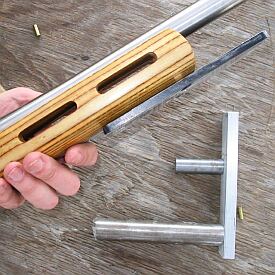 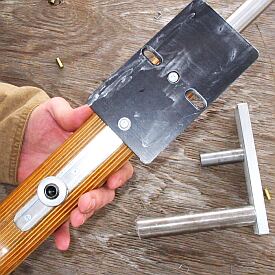
Special Modifications for Benchrest and F-Class Shooting
I like to do my initial load development from the bench. I've also toyed with the idea of using the Barnard BRX in F-Class matches. Accordingly, I wanted to be able to use a pedestal front rest and rear sand-bag. For the front, we simply modified a Hart Accuracy Asset to fit the Mastin forearm. As seen in the photos, it just bolts right on to the accessory rail. This provides a wide, stable platform that rides the front rest well.
Getting the gun to track well in the rear was more challenging because the butt is offset from the gun's centerline. This caused it to pitch, roll, and yaw during recoil. My smith devised a swiveling fixture, aka "Parker Pod", for use with a rear sandbag. The Pod attachment (which adds 2.5 lbs to the gun's total weight) fits the same hole used for the Mastin adjustable butt-plate. The upright part of the Parker Pod swivels so you can align it straight up and down. The bottom part allows the rifle to ride in the rear bag via a bar parallel with the barrel. With this set up, tracking is excellent and you can even free recoil the gun if desired."
-- Scott Parker --

Photos by Paul McM. All material Copyright © 2005, 6mmBR.com, All Rights Reserved. No reproduction of any content without advanced permission in writing.


|
|